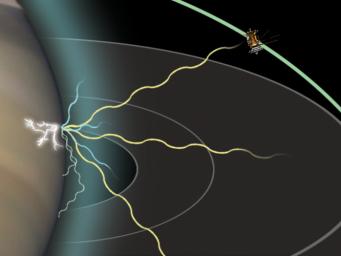
|
Detecting Lightning From Saturn
- Click the image above for a larger view
- Full-Res JPEG (720 x 540) (25.9 kB)
- Full-Res TIFF (720 x 540) (681.3 kB)
Caption:
This artist concept shows how Cassini is able to detect radio signals from lightning on Saturn. Lightning strokes emit electromagnetic energy across a broad range of wavelengths, including the visual wavelengths we see and long radio wavelengths that cause static on an AM radio during a thunderstorm. Some of the radio waves propagate upwards and can be detected at long distances by the radio and plasma wave science instrument on Cassini.
One barrier to the radio waves, however, is Saturn's ionosphere, a hot, ionized layer above the atmosphere that can block low frequency radio waves. The low frequency waves are either reflected or absorbed by the ionosphere. The higher frequency waves can pass right through the ionosphere, however, and subsequently be detected by Cassini. By measuring the lowest frequencies that can be detected by Cassini, scientists can determine the density of Saturn's ionosphere.
Background Info:
The Cassini-Huygens mission is a cooperative project of NASA, the European Space Agency and the Italian Space Agency. The Jet Propulsion Laboratory, a division of the California Institute of Technology in Pasadena, manages the Cassini-Huygens mission for NASA's Science Mission Directorate, Washington, D.C. The Cassini orbiter was designed, developed and assembled at JPL. The radio and plasma wave science team is based at the University of Iowa, Iowa City.
For more information about the Cassini-Huygens mission, visit http://saturn.jpl.nasa.gov and the instrument team's home page, http://www-pw.physics.uiowa.edu/plasma-wave/cassini/home.html .
Cataloging Keywords:
| Name | Value | Additional Values |
|---|---|---|
| Target | Saturn | |
| System | Saturn | |
| Target Type | Planet | |
| Mission | Cassini-Huygens | |
| Instrument Host | Cassini Orbiter | |
| Host Type | Orbiter | |
| Instrument | Radio and Plasma Wave Science Instrument (RPWS) | |
| Detector | ||
| Extra Keywords | Artwork, Atmosphere, Color, Magnetosphere, Radio, Storm | |
| Acquisition Date | ||
| Release Date | 2004-08-05 | |
| Date in Caption | ||
| Image Credit | NASA/JPL/University of Iowa | |
| Source | photojournal.jpl.nasa.gov/catalog/PIA06414 | |
| Identifier | PIA06414 | |
